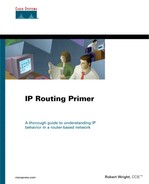Introduction to the 32-Bit IP Address
An IP address consists of four sets of octets (eight bits per octet), or 32 bits. IP addresses are typically written in a format referred to as dotted decimal format. In other words, the number base is decimal and the sections are denoted by dots (.). A Class B address representation is as follows: 10.1.23.19.
10. 1. 23. 19 (decimal)
00001010.00000001.00010111.00010011 (binary)
10.1.23.19 is much easier to work with than its binary equivalent, 00001010.00000001.00010111.00010011. It is important to note that they both have the exact same meaning.
Classes of Addresses
These four octets are broken down to provide an addressing scheme that can provide for large and small networks. Although there are five different classes of networks (A to E), you will only be considering classes A to C. To differentiate between different classes of addresses, look at the first octet of the dotted-decimal address:
* Class A: 1 - 127 (e.g. 10.1.23.19) (0.0.0.0 and 127.0.0.0 are reserved)
* Class B: 128-191 (e.g. 172.16.19.48) (128.0.0.0 and 191.255.0.0 are reserved)
* Class C: 192-223 (e.g. 193.18.9.10) (192.0.0.0 and 223.255.255.0 are reserved)
Note
The reserved addresses used in the section on IP address classes are commonly referred to as martian networks. Routing protocols such as RIP and IGRP running on IP connectivity devices, such as routers, should ignore routing advertisements for martian networks. The reserved addresses given represent the minimum set of martian networks that should be recognized. It is possible to add additional martian networks as requirements dictate. If you are interested in learning more about martian networks, try using your favorite Web search engine. Search on martian networks or GATED (Gateway Routing Daemon). GATED is the application used on UNIX systems and some routers to manage dynamic routing information. A DAEMON is a background process that monitors incoming IP packets for system requests it should service. Just as GATED handles dynamic routing information, NAMED handles Domain Name Service (DNS) requests.
Note that classes D and E exist but are reserved. Class A addresses have the first octet dedicated as "network" or Internet portion, with octets 2, 3, and 4 available for local subnets and hosts. The concept of subnetting is explained later in this chapter. Allocation of Class A addresses is severely restricted due to the limited number available.
Class B addresses have the first two octets dedicated as the Internet portion, with octets 3 and 4 available for local subnets and hosts. These Class B addresses are typically used for intermediate-sized networks that have between 256 and 65,536 hosts. Obtaining a Class B address is becoming very difficult because there are so few left.
Class C has the first three octets dedicated as the Internet portion, with octet 4 available for local subnets and hosts. Class C addresses are perfect for those networks with fewer than 254 hosts. Class C addresses remain fairly easy to acquire. Companies that have more than 254 hosts need to request multiple Class C addresses. Example network numbers are illustrated as follows:
* Class A: assigned network 10.0.0.0
* Class B: assigned network 172.16.0.0
* Class C: assigned network 192.151.10.0
See RFC 1918, "Address Allocation for Private Internets," for more information on available IP addresses and strategies for implementing IP addressing in your network. Appendix A, "RFCs," has information on where to obtain this and other RFCs.
Default Subnet Masks for Class A, B, C, and D Addresses
All classes of IP addresses have a default mask, often referred to as the netmask. The default netmasks are as follows:
* Class A: Network mask 255.0.0.0
* Class A: 0.255.255.255 Host bits
* Class B: Network mask 255.255.0.0
* Class B: 0.0.255.255 Host bits
* Class C: Network mask 255.255.255.0
* Class C: 0.0.0.255 host bits.
These masks are sometimes referred to as subnet masks, although technically this is not accurate. They are really network masks. These masks only cover the range of bits reserved by default for the class of address in question. The concept of a subnet mask is "to further subdivide a (major) network into smaller (sub) networks." Hence the terms subnetwork and subnetwork mask, which are usually shortened to subnet and subnet mask, respectively. Thankfully, most people use the term subnet mask to refer to either a network mask or a subnet mask. The next section explains what subnet masks are and how they are used.
